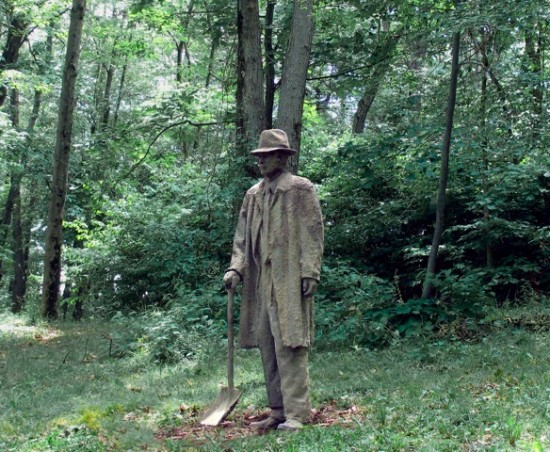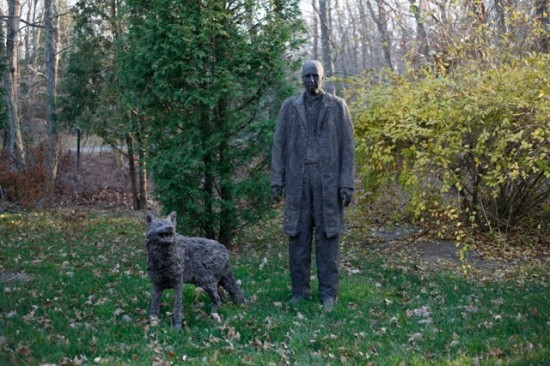There are a few things to know about James Croak: The artist favors dirt as the main material in his hand-built cast sculptures. He invented the labor-intensive process to use the natural material after turning from abstraction to make figurative work. His art is poignant.
Croak's art provides windows into intimate human experiences. His work is currently the subject of a solo show at Oxenberg Fine Art in Miami, FL. The exhibition presents three life-size works and two tabletop sculptures.
.

"The Mind / Body Problem, portrait of Marcel Duchamp" by James Croak. Cast dirt, 31 x 20 x 11 inches. Courtesy Oxenberg Fine Art.
.
Croak's detailed process is way of ensuring that poetics and a life force are integral parts of the work. Armatures for the sculptures are made from hand-built clay and then cast, representing hundreds of hours of labor.
"It is the process of building up the figure, muscles and skin from scratch that gives the work animation and poetry," said Croak during an interview with Barbara Bloemink, Curatorial Director, National Design Museum, Smithsonian, according to Croak's website.
.

"Dirt Man with Shovel" by James Croak. Cast dirt, 74 x 30 x 35 inches. Courtesy Oxenberg Fine Art.
.
Croak selected dirt as his primary material around 1985, according to his website. The "worthless" material was selected for its sheer abundance in his new Brooklyn neighborhood after moving from Los Angeles, CA, said Croak during an interview with Bloemink.
Croak now makes his art in Sag Harbor, NY in the Hamptons.
.

"Dirt Man with Wolf" by James Croak. Cast dirt, 77 x 30 x 30 inches. Courtesy Oxenberg Fine Art.
.
Miami-based arts writer and curator Margery Gordon caught up with Croak and had a virtual exchange about the works in his solo show and the ways his work relates to art history and philosophical matters.
Q & A with James Croak for Hamptonsarthub.com
By Margery Gordon
The gritty surfaces of James Croak’s life-sized figures, cast in his signature dirt mixture, resonate with an elemental relativity. The Ohio native and longtime New York resident has exhibited his distinctive sculptures extensively around the U.S. and Europe for 30 years. His latest solo exhibition is currently on view at Oxenberg Fine Art in Miami’s Wynwood Art District.
HAH! What inspired you to become an artist?
JC: The formalist sculpture of Rosati, Tony Smith, Cubi series of David Smith and a few others. For me it was the zenith of thought, and of course they marketed it as such, so I fit right in. Oh, how the times would change. I went to art school 1969-73, at the end of Modernism, which was still being taught. Odd to get an education in something that almost immediately became passé. Curiously, I studied philosophy at another school simultaneously that was immersed in structural thought; it also hit the dustbin shortly thereafter and for the same reasons. Perception and conclusion were revealed to be a form of imagination.
HAH!: Who were your formative influences, and what role have they played in your development as an artist?
JC: Rodin for figurative art, Duchamp for idea art, Tony Smith for beautiful form, Rauschenberg for adventurist experimentation.
HAH!: One of the newest sculptures in your current show at Oxenberg Fine Art is a bust of Marcel Duchamp. Why did you create this homage? What relevance does his legacy have to your work and your views on art?
JC: Duchamp’s hyper-relativity became the conclusion of the 20th century; we closed out the millennium with no compelling or consistent philosophy of the world. The odd outgrowth is now an uber-shiny, hyper-pop, unabashedly glib art which presently dominates the scene, eschewing any kind of subjective or unconsciousness, which pointedly used to be what art was. I’m problematizing this conclusion by pointing out that his mechanism of thought is organic biology, known in philosophy as the “mind body problem,” and that Duchamp’s conclusions are his own layered history.
HAH!: How did you come up with your trademark technique of casting dirt into figurative sculptures? What meaning does this material confer on your work?
HAH!: I saw a taxidermist use glue and sawdust to make hooves for my sculpture Pegasus. I tried to replicate the sawdust but didn’t have enough, so I tried dirt and it worked. Dirt is such a powerful medium — although presently at odds with current style — that I never fully got away from it. It's the extreme material; anything else feels watered-down to me. One has to do only objects that are originally dirt, such as flesh or a tree — doing, say, a dirt toaster probably wouldn’t read correctly.
HAH!: Some of your pieces incorporate animals alongside humans, including the new sculpture pairing hooves with oversized hands. What are you trying to express about the relationship between mankind and the animal kingdom?
JC: Images mixing humans and animals are found in all cultures dating back into prehistory. If there is a collective unconsciousness, these hybrids must be there.
HAH!: You have written for various publications and profess an interest in science and philosophy. How do these other disciplines relate to your visual practice?
JC: I’m rather proud to be invited to write for Edge.org, as the talent there is stellar, but actually the group was begun by artist James Lee Byars, who believed he could solve world problems by getting the best minds in one room and asking them the same deep question.
HAH!: When and why did you purchase a home in Sag Harbor?
JC: I always looked longingly at the Hamptons, as I had lived in urban centers all of my life: Chicago, L.A., NYC. I never owned a house or had a yard – this was all very exotic for me. When the market dropped severely, I bought an acre with a house on it. I wrote a piece about moving to the country to make art, as many artists are: “Art Making Going Rural” by James Croak:
www.edge.org
.

"Untitled" by James Croak. Cast dirt, 3 x 28 x 43 inches. Courtesy Oxenberg Fine Art.
.
BASIC FACTS: "Sculptures by James Croak" are on view at Oxenberg Fine Art from March 28 to April 27, 2013. A closing reception and panel discussion takes place tonight (Thursday, April 25) at 7 p.m.
Margery Gordon will moderate a panel on the subject of materiality and will explore the use of unexpected materials and innovative methods by Croak and other artists. Panelists include conservator Gordon A. Lewis, Jr., appraiser Dorothy I. Long, and Lucinda Linderman, an emerging Miami-based sculptor who transforms recycled materials in a tactile commentary on human consumption. Gordon is a gallery curator for Oxenberg Fine Art.
Oxenberg Fine Art is located at 50 NE 29 Street, Miami, FL 33137. www.oxenbergart.com
James Croak: www.jamescroak.com.
HAMPTONS INSIDER:
Croak's work was exhibited in a group show at the Parrish Art Museum in 2007. The exhibition "All the More Real: Portrayals of Intimacy and Empathy" was curated by Eric Fischl. Fischl is based in North Haven, NY in the Hamptons.
________________________________________
© 2013 Hamptons Art Hub LLC. All rights reserved.




